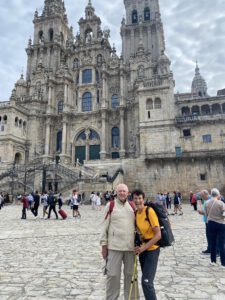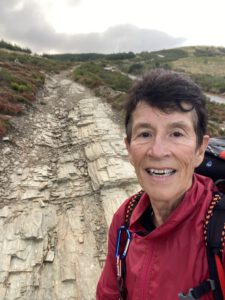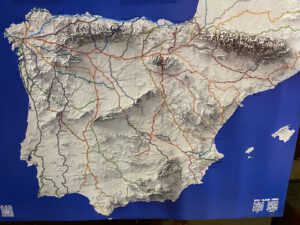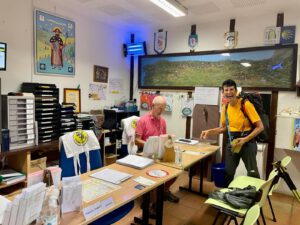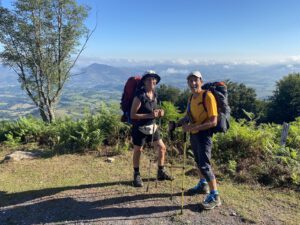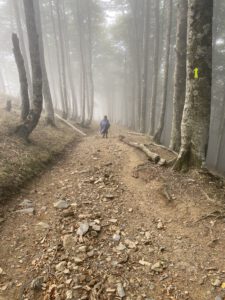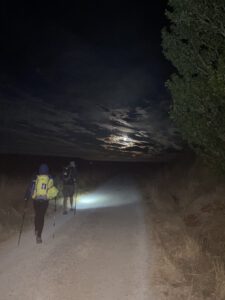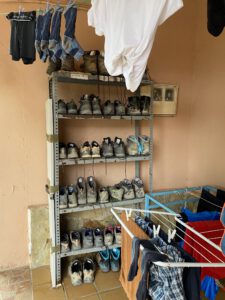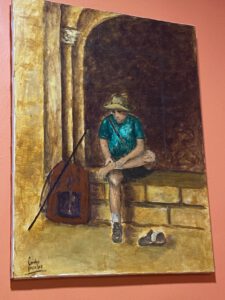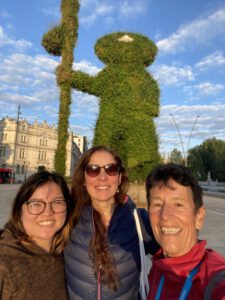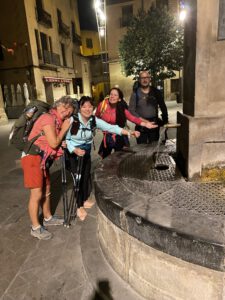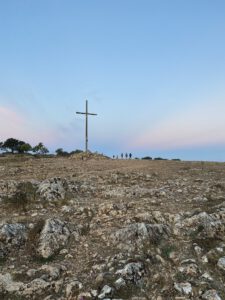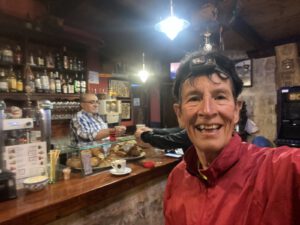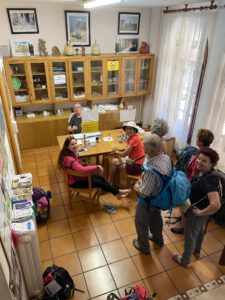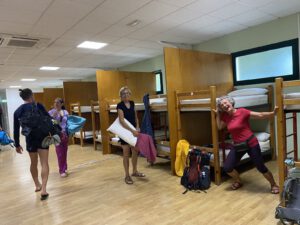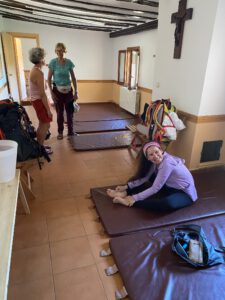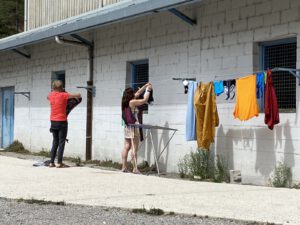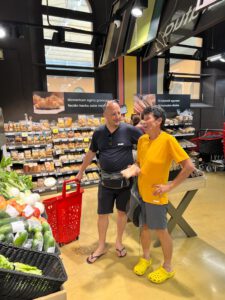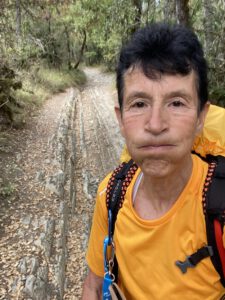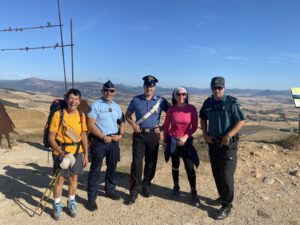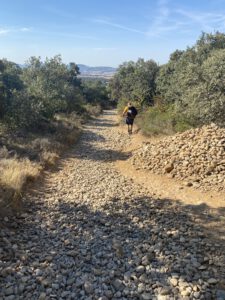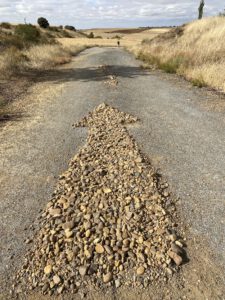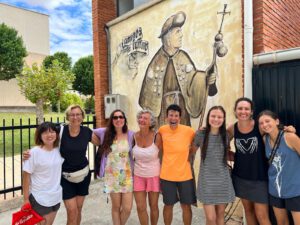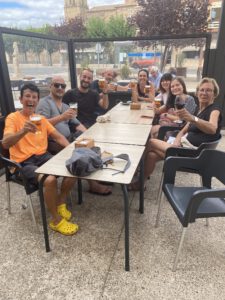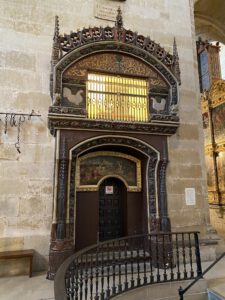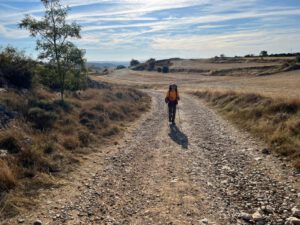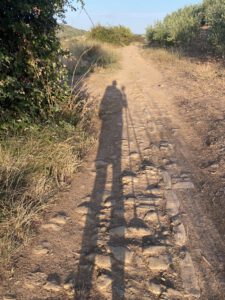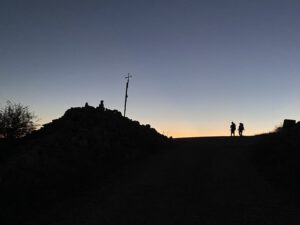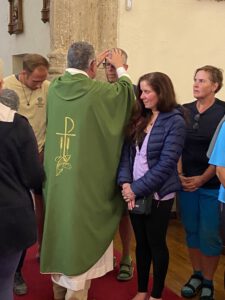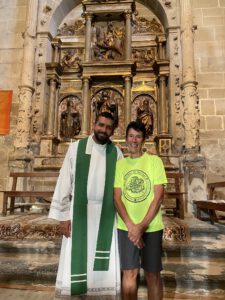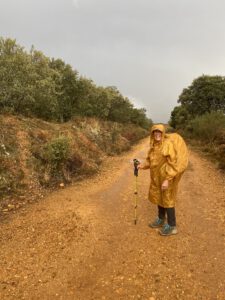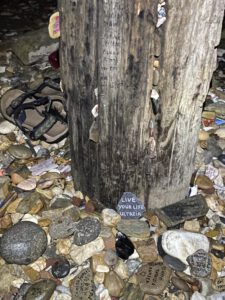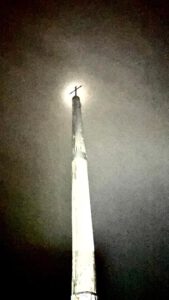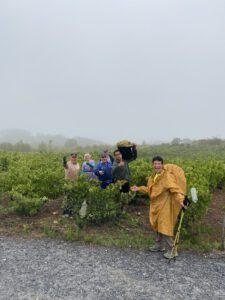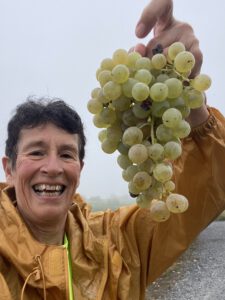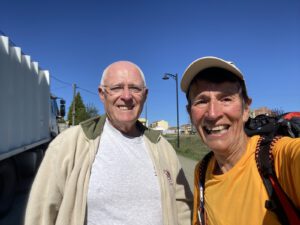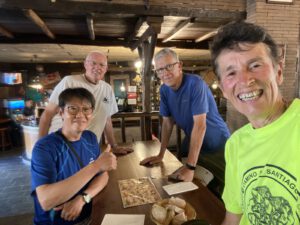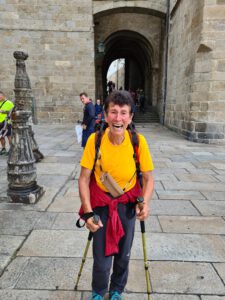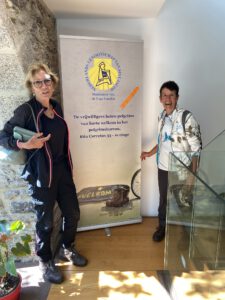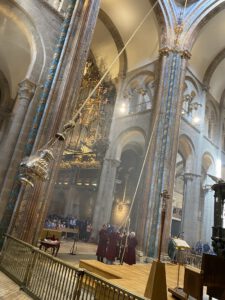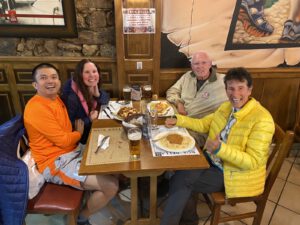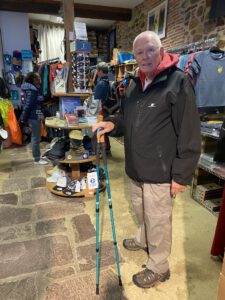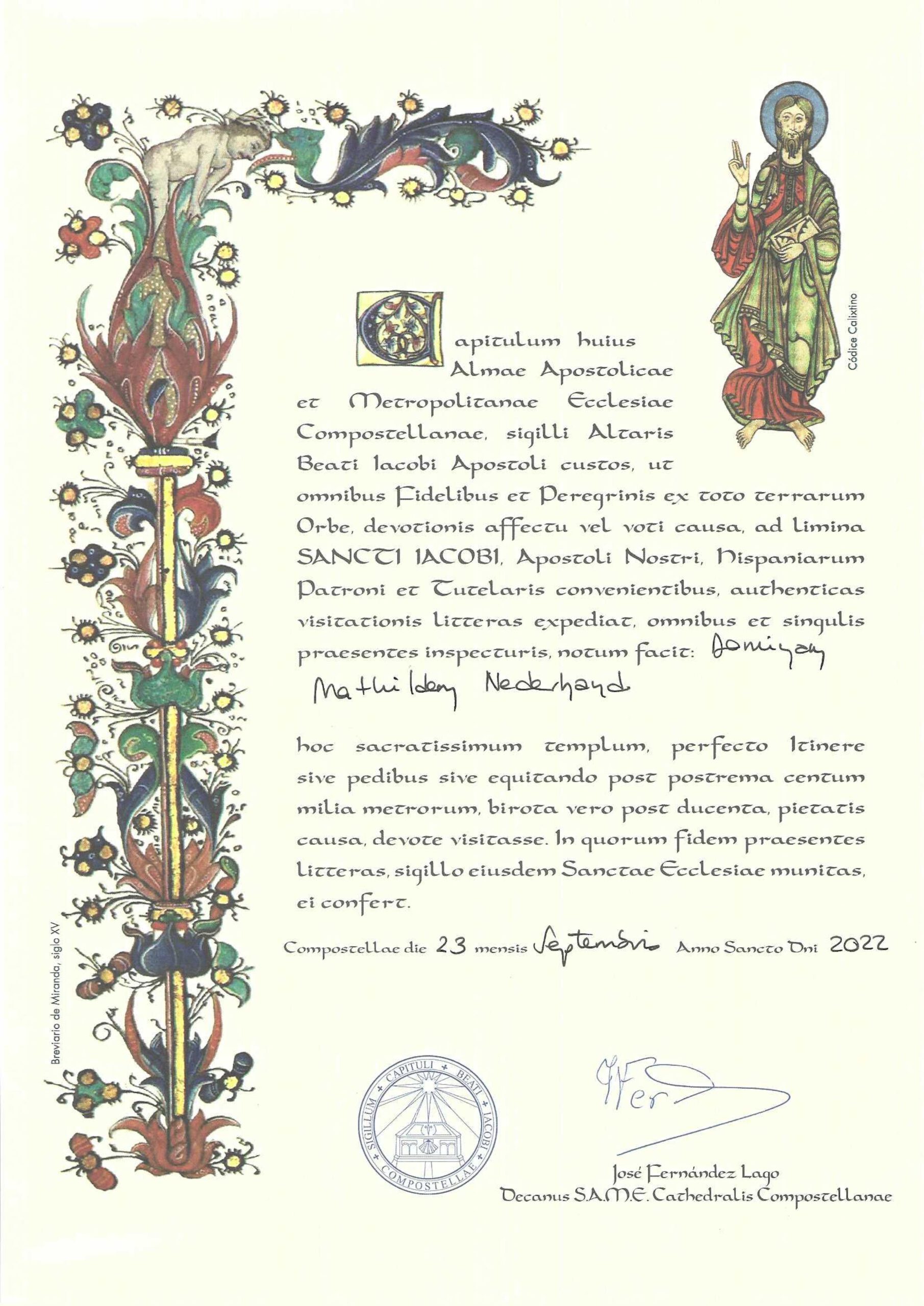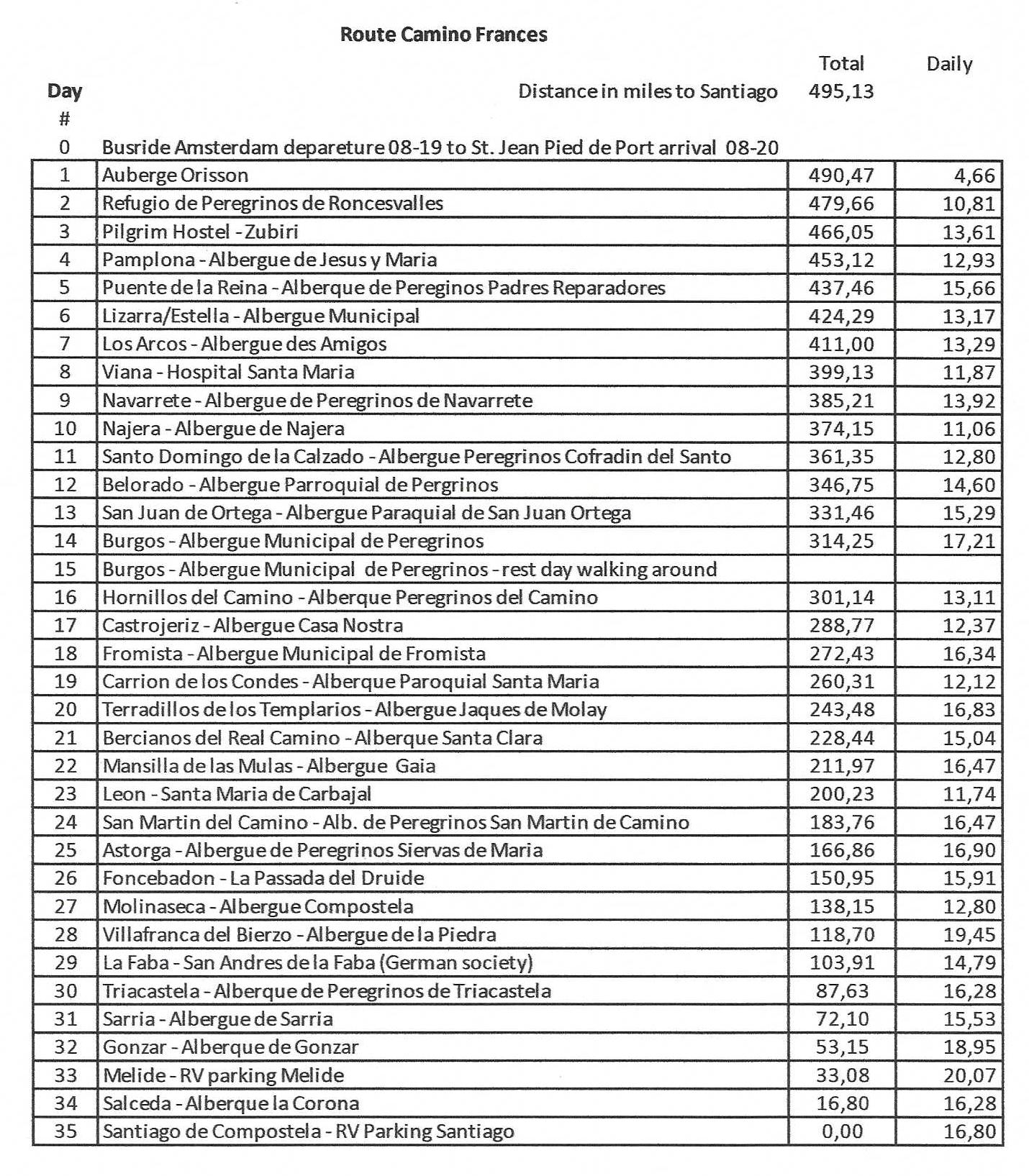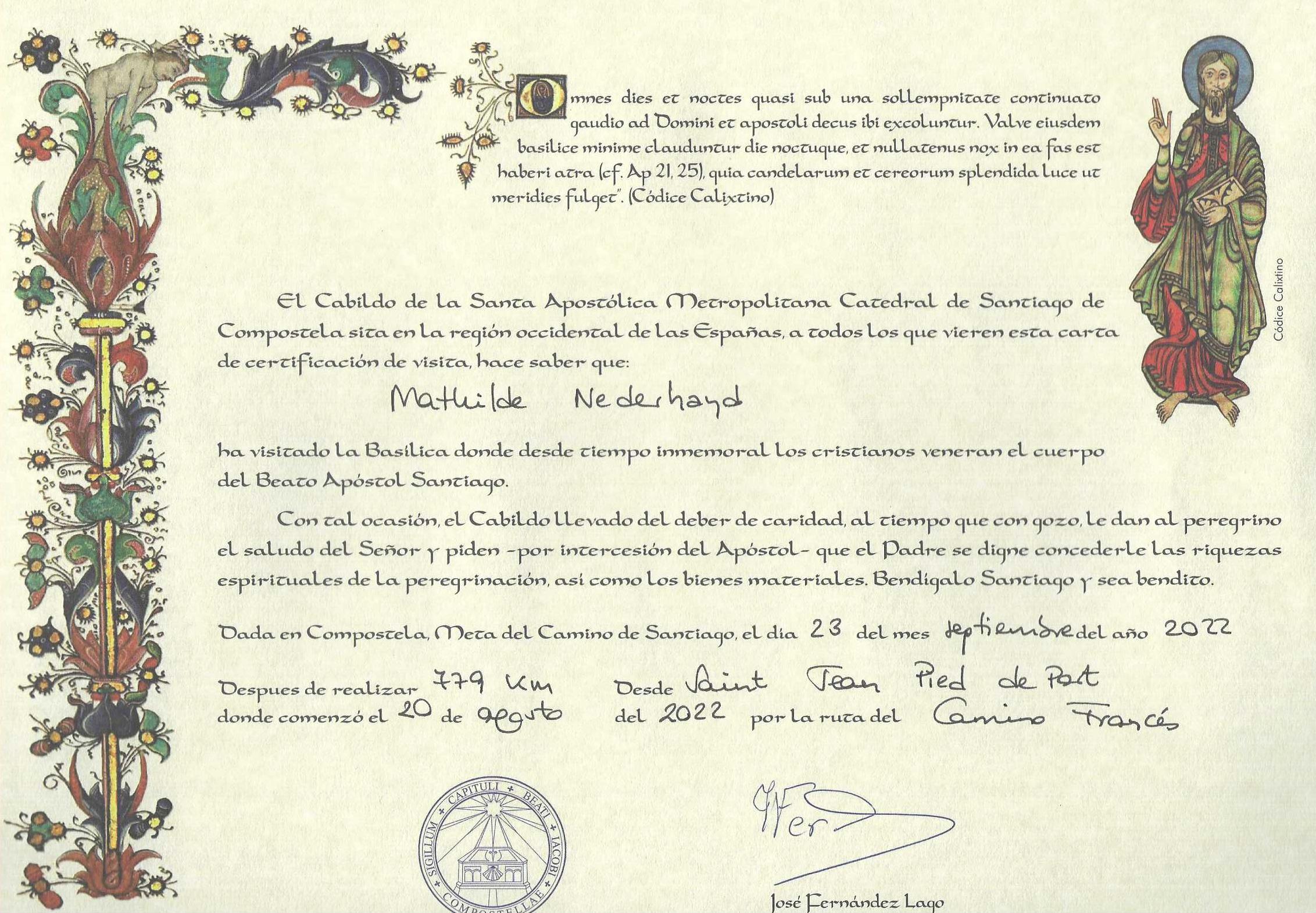A short impression of my life on the “Camino Frances” – Way of St. James
August 20th 2022 till September 23th 2022
It has been several weeks since I arrived, after a walk of almost 500 miles, in Santiago de Compostela, Spain, a place of pilgrimage where, for more than 1000 years, pilgrims have been going.
A incredible experience, especially because Dick was waiting for me in front of the Cathedral of Santiago. But it also marked the end of a special hike and a return to normal life. Unfortunately I became ill the day after arrival, probably picked up a virus and developed a severe bladder infection. I couldn’t walk any further, so after spending two more days in Finisterre, Dick drove back home. There I find out that I lost weight. The scale remains at 110.67 lbs, while on departure, it really indicated 126 lbs. No wonder I was susceptible to a virus.
Fortunately, I now fully recovered and even gained 4.6 lbs.
At home in the meantime Dick has bundled my daily notes of this pilgrimage, added pictures and printed everything, so now I have a report of this (for me special) trip. Unfortunately, the size of this document, which consists of 84 pages, is too large to post this document on our website, so nothing has been published of my experiences yet. I think my daily notes would also be boring to everyone because my daily life on the Camino Frances was much the same.
I do look back on a special trip and find it difficult to describe how I experienced it. I do know that I am very grateful that I was allowed to walk this Camino (gratitude was also my reason for walking).
It was a long and at times also difficult walk. Yes often there were regular paths and even roads you walked on but there were also steep paths that led up and down and consisted more of rock slabs or loose gravel so that it was more like climbing and sliding down. At that moments I was really happy with both my walking sticks.
Before telling you something about my life on the Camino Frances to Santiago, first a little about its origins.
After the Apostle St. James went to preach Christianity in Spain, he returned to Judea where he was beheaded in the year AD 44. It is not clear what happened to his body, but a legend tells us that his body was placed in a boat that miraculously washed ashore on the coast of Galicia in Spain. Designated by a brilliant star, his body and coffin were discovered by a hermit in the 9th century. When it became clear that this was the final resting place of the apostle St. James. In Spanish his name is Santo Lago, which was shortened to Santiago. The apostle Santiago was proclaimed the patron saint of Galicia, later he even became the Patron Saint of all of Spain. A small church was built, followed by a pilgrimage. At the end of the 11th century, construction of a cathedral started on this place in Santiago de Compostela.
At about the same time in the 9th century, Emperor Charlemagne (Charles the Great) had a dream, calling on him to free the pilgrimage road to the tomb of the apostle Santiago in Galicia from the enemies of the Christian faith. The Emperor looked up into the night sky and saw the route to follow, the star-studded Milky Way that pointed from the north toward Galicia.
It is special when I read this because, in the early morning when it was still night, I also was led by a very bright star, which pointed the way to Santiago. It also explains the second verse of my “Ultreia” song which reads as follows:
Chemin de terre et chemin de foi (way of earth and way of faith)
Voie millenaire de L’Europe (thousand years old road in Europe)
Le voie lactee de Charlemagne (the milky way of Charles the Great)
C’est le chemin de tous les jacquets (it is the path of all the pilgrims)
Today there are many pilgrim roads that all lead to the Spanish city of Santiago de Compostela. The most famous is the Camino Frances. I followed this classic pilgrimage route from France to Santiago de Compostela.
My starting point was Saint Jean Pied de Port in the French Pyrenees, where I arrived August 20th at 6.30 am, after a rather tiring bus ride of 20 hours.
Dirkje is also on the bus, she was one of the participants in the mini pilgrimage. It’s fun because now we can chat and also begin our pilgrimage together.
Because in the pilgrim’s office here (acceuil Pelerin) the first stamp has to be obtained in our “Credential del Peregrino” (pilgrim’s passport).
But it‘s still closed and we have to wait until this office opens at 8 am. Unfortunately, everything in this town is still closed, nothing is open, not even to have a drink, so we kill the time by talking and I also walk to the Boutique du Pelerin, located opposite. In May I bought a lot of my equipment in this shop. I now can tell them that I am very satisfied with the equipment they sold.
After receiving our first stamp and having lit a candle in the church, the ascent of our first stage can really start. It’s immediately a tough climb, after all, we have to cross the mountains of the Pyrenees.
I am so glad that Dick reserved a bed for me in Albergue Orisson. It means that, after a night of practically no sleep, we only have to climb 4.14 miles instead of 16.27 miles. The weather is beautiful, the sun is shining and the sky is steelblue and I am happy. The view over the imposing mountain world is beautiful. We arrive in Orisson at 11.30 am. The rest of the day is spent by hanging out in the sun, drinking water, talking and have some sleep.
The next day, stage 2, I climb further up through the Pyrenees together with other pilgrims. The sun has given way to fog and it gives this walk something mysterious, especially when we walk along trees growing on steep slopes. After crossing the border to Spain, only a pole shows that we have left France, a steep descent starts that lasts endlessly and forms an attack on my legs. It is therefore not surprising that, when I arrive at the bottom of the valley in Roncesvalles, where Dick and I spent the night with the motorhome earlier this year, tears are streaming down my cheeks. It is still too early to check in at the Albergue de Peregrinos, but the wait is not annoying, with all the pilgrims here. We chat, laugh and drink schnapps, brought by the Croats Jago, Myra and Maria and we relax.
This waiting time allows me to get to know my fellow pilgrims better and better. Important because I will spend the next weeks with them, will walk together for a while and will meet them again in the evening in the albergue, will go shopping together and eat and stay in the same dormitory. Unfortunately, during the long walk, the group breaks up, but then I meet other pilgrims.
Actually, the daily rhythm was the same every day.
Get up, get a wet cloth over your body, and pack your backpack.
During the trip my time to get up, shifted from 6 am to 4.50 am. Not really handy because the time when it gets light also got a little later every day, so I had to walk longer and longer with my headlamp. But it was nice to go out early morning because it meant that, almost always, I arrived around noon at my destination.
Over time I noticed that I became more and more adept at grabbing everything in the dark in the dorm and putting it in my backpack. Fortunately my headlamp also had a red light which caused less nuisance for the pilgrims who were still asleep and still it gave enough light to see or I packed everything.
Have some breakfast, usually in the shared kitchen of the albergue, taking care of your feet and legs and putting on shoes.
I preferred a breakfast with yogurt or custard, but sometimes I also had a sandwich or croissant with cheese spread and salami. I almost never had a baguette because the next day it was too old.
After breakfast everyone put on their shoes, after first taking care of their feet. If needed because of blisters, feet were wrapped with Leukopor (paper tape) and in my case my legs were well lubricated with physio cream, to keep my muscles flexible. In every albergue the shoes are put in a cupboard near the entrance, so there were never smelly shoes in a dormitory nor was the floor ever smeared with dirt from the shoes.
Unlike the many other pilgrims who walked with me, I only got two blisters. They disappeared on their own when I wrapped it with Leukopor. After a week I did get a lot of trouble with my shinbone, had shooting pains in that leg and my leg and part of my ankle was clearly thickening.
Fortunately, there were pharmacies everywhere along the way (I have never seen a country with so many pharmacies). There, after taking a look at my leg, immediately ibuprofen ointment and ibuprofen pills (painkiller and anti-inflammatory) was dispensed.
So I was able to keep going on, although I tried to slow down, take slower steps and descend more carefully. I also wanted to stop several times earlier than the day-stage indicated. However, that never happened because the places I wanted to stay were either very dead or I arrived there already around 9 am and that was really too early to stop.
I did take a rest day in Burgos (after stage 15) to spare my shinbone.
However, when I look back on this rest day, I wonder if that goal was achieved. Although I was allowed to stay a second night in the albergue municipale in Burgos (normally you can only stay one night in a albergue) and I was able to leave my backpack in a shed.
However I myself had to leave the albergue before 8 am and could not check in again until 1 pm to get a bed.
Fortunately, Danielle from Brazil and Dewi from Indonesia also had a rest day, so the three of us could explore the city. Because everything was closed until 11:30 am (so it was completely extinct in the city), we regularly sat on a terrace that morning and had café con leche (coffee with milk). And as far as the pain in my leg is concerned, the rest day probably helped because at some point after this day, I could walk again normally without any pain.
Leave the albergue, set off and walk the chosen day stage.
It was important to tap water in your water bottle in the morning. I always had 1.5 quart with me which was more than enough. I soon found out that the water you could tap from the springs along the road did not taste really good. It mostly had a chlorine taste. So if it was possible, I bought the day before 1.5 quart of water con gaz (with bubbles). This water was much more pleasant to drink, especially when it got warm.
The departure was often with a group, but when I got closer to Santiago, I usually left alone. Walking together had its charm because you were regularly talking to each other about all kinds of subjects and before you knew it, you already walked a great distance. But it also turned out that walking alone and being busy with your own thoughts was very important too, it had its own charm and was quite nice. I loved that.
Because I always left early morning, the first hours I walked in the dark so my headlamp was indispensable. Not always nice because all the insects from the wide area flocked around your head. It became all the more pleasant when the night with its clear starry sky was slowly dispelled and the cold disappeared a little later by the sun’s rays. Usually after 5 miles (sometimes after 6 miles) we managed to find a bar where cafe con leche was available. Especially when it was cold in the early morning (the temperature regularly did not rise above 50 degrees Fahrenheit), this hot drink was very pleasant to warm up. Occasionally a tortilla or a fresh baguette with bacon and eggs or with the delicious Spanish jamon, was irresistible and I ordered that too.
Sometimes the town, that was the intended end point, turned out to be so dead that it was wiser to walk a little further. This happened several times in the second week when shooting pains regularly shot through my shinbone. Every day I decided to walk a shorter distance and therefore stop earlier, but it never happened.
Arrive at the albergue and the stay there.
Because I always left early morning, I usually arrived at the albergue before it opened. I therefore always had to wait until I could check in. I preferred those albergues where you couldn’t make a reservation, often albergues municipale (an albergue sponsored by the local municipality).
Here was: the first to come has the first bed. Another possibliblity was the donativo (an albergue, often associated with the church, where you can decide yourself what you want to pay for it. The intention is that you pay a realistic amount).
To be allowed to spend the night in an albergue on the Camino, you must be able to present a “Credential del Peregrino”, a pilgrim pass. Because you have to present it with your passport it‘s on the name in your passport. This credential will be stamped while also a photo is taken of your passport. The latter was not really nice for people who like to protect their data, but without a picture no access.
Most albergues have dormitories with bunk beds, sometimes with only 6 bunk beds, but there are also albergues with 20 bunk beds or more. In the latter case, partitions are often placed between the beds so that it appears less massive. Because I was always one of the first to check in, I had one of the first beds that were issued, so I always got a downstairs bed. My age must also have played a role because the elderly have more right to a downstairs bed than the young ones. Nice because there were sometimes bunk beds without stairs where you just had to find out how to reach the top bunkbed. Nearly every albergue had a mattress and pillow covered with plastic or skai. Unpleasant to lie on, but it can be cleaned well and therefore is hygienic. Because you get a paper mattress- and pillow cover in almost every albergue when you check in, it is still good for sleeping. Fortunately I never had a bed with bedbugs. Well I found out that some people sprayed their bed thoroughly before taking it.
The albergue in Viana is somewhat different. It is a donativo and belongs to the adjacent church. If we want to check in here with a group, we are told that there are no beds. After climbing endless stairs, we arrive in a room where a row of thin sleeping mats lie on the floor. We look at each other and decide to stay here anyway. As a pilgrim you also should experience this. It is significantly more primitive than sleeping in a bed and the mats are so thin that you are actually lying on the hard, wooden floor so the next day we wake up shattered. The washroom is also somewhat limited (there is only one shower and sink) but the communal meal after the pilgrim mass, as well as the breakfast served the next day, is excellent and so this Albergue deserves that people stay here.
The procedure in an albergue, after your bed is assigned and you put your sleeping bag on your bed, is that you take a (practically everywhere) warm shower. I can tell you that, after a 6 to 7 hours walk, nothing is as wonderful, than standing under a warm shower.
The next task is to wash your clothes. Often that is a separate place near the garden, where the washing lines are, sometimes there are sinks in the garden. There are sometimes washing machines, but I only used them once (in Pamplona, they were free of charge). Once the clothes hang on the clothesline to dry, the chores are done.
After arriving and washing their clothes, most pilgrims hang around, lie on their beds, chat with each other, take care of their feet and legs and sleep a bit.
I personally liked to walk around town in the afternoon. Sometimes they were very picturesque and old and of course, if not closed, I visited the local church. By 5 pm, when the shops in Spain open again, every pilgrim visit the local supermercado to buy food. Most of the albergues have a kitchen where you can prepare food or heat it in a microwave. And then you eat together. It is always nice to eat, chat and drink a glass of wine together and talk about the stage we walked and the stage to come.
It never gets late in an albergue, at 10 pm the lights go out. Occasionally, when there is a late pilgrim’s mass, after which you have a shared meal together, I could not go to bed until around 9.30 pm, but usually my bedtime was much earlier and I was in bed around 8 pm. I sleep everywhere and always and I was not bothered by the sleeping sounds of the other pilgrims so I never wore earplugs. Only once in the 33 nights that I slept in an albergue, I woke up. That was because fellow pilgrims started clapping to wake someone who was snoring very heavily. It wake me but not the snoring pilgrim.
Some impressions about the walk on the Camino Frances.
I walked the entire Camino Frances in 34 stages. I started at the foot of the Pyrenees. The first stages up to Pamplona were quite mountainous and we regularly had to climb steeply and there were steep descents. The road sometimes led through a town and over a normal path, but you also came across rock slabs on this part (but also later) that were quite difficult to climb and descend.
From Pamplona to Burgos the route was mostly hilly. There is a long and steep climb up to Alto del Perdon, I walked (climbed) it with Bertold, Andres, Dewi and Danielle so we were distracted from the climb, we were welcomed at the top of this hill by policemen from Spain (guardia Civil), France (gendarmerie) and Italy (carabinieri). Of course everyone wants to take a picture with them and have a chat.
By the way, it is striking that there are so many policemen along this Camino Frances. Even on the most remote roads you regularly see a car of the Guardia Civil driving by, the cobs always wave encouragingly at you.
After staying quite a long time on the top of the Alto del Perdon and making a lot of pictures, there are nice sculptures here, we have to start the descent and this is dramatic. There is only a dried water channel, I am so glad there is no rain, that is filled with rolling pebbles and descends steeply. You really shouldn’t have trouble with your knees and otherwise you will get it here. Without walking sticks it’s impossible to descent and only by taking very short, almost running steps, you reach the valley. Apparently I am asking too much of myself on this descent because after also walking the last 3 miles on a sunny, snow-white sandy path (without sunglasses), I pass out when I finally arrive at the albergue in Puente de la Reina. Fortunately, with the help of my fellow pilgrims, I quickly recover and after sitting in the garden for a while, I can resume my daily routine and in the afternoon even wander around the old town with Dirkje and look for a geocache.
Finding the way to the next destination is normally not that difficult because everywhere you can see either the St. James shell or a yellow arrow drawn on a house or pole, sometimes there are even stones on the road in the shape of an arrow. When they are outside, you can also ask the locals or you are on the right track (they wave in the direction where the Camino runs) or you can follow the backpacker in front of you. This is not always a guarantee that you are following the right path.
Unfortunately, none of this works if you leave early in the morning, when it’s still really dark and you’re alone on the street. The arrows are often difficult to see and once you are lost (indeed, this happened to me a few times) there is only one option and that is to open the “Camino Ninja” app which will eventually get you back on the right track.
On your way through the beautiful Spanish countryside you often come across herds of sheep. It is always a beautiful sight to see sheep pouring out like a tidal wave over the fields but I did not like it when I come across such a herd in the small streets of a village where these smelly animals almost knock you over.
And then it’s August 26th and it’s my birthday. A large number of fellow pilgrims know that I am celebrating my 70thbirthday today and when I get up at 5 am, I am already congratulated by Alessandra from Italia and Dirkje gives me a beautiful magnet with an image of the Camino. What a treat.
Today the distance is only about 13.5 miles, so at the end of the morning we gather at the albergue in Los Arcos.
After we have been allocated a bed, taking a good shower and the laundry is flapping on the clothesline, we take a nice picture of the women and men of our regular group and then we walk together to one of the restaurants on the main square where we raise our glass on my birthday and that of Daniella from Columbia.
She is celebrating her 27th birthday. It is nice to be sung to by this international group of pilgrims. After this drink we also have a pilgrims dinner together. A memorable birthday and great to look back on.
We now leave almost every morning in the dark, but that is no problem with our headlamps. We are guided by a brilliant bright star and the Milkyway stretches above our heads. It is special to walk so early and it becomes even more beautiful when at some point the night gives way to twilight and then the first rays of sun illuminate our path. The clicking of our phones does not stop then.
A special place on the Camino Frances is the cathedral of Santo Domingo de Calzada, where we arrive on August 30th (stage 11). Immediately upon entering the cathedral I hear a rooster crowing and it continues to do so several times in succession.
Unfortunately when I later have my phone ready to record that, the rooster refuses to make any further noise.
The story behind this rooster and hen in the church is as follows:
A family on their pilgrimage in the 14th century, spent the night in an albergue. The innkeeper’s daughter tries to seduce the son, but when he does not comply, the girl accuses him of theft and puts silver cups in his bag. The boy is then convicted and hanged. The grieving parents continue their way to Santiago. On their return journey they find out that their son is still hanging on the gallows and is alive. Apostle Santiago has held him all this time. They visit the judge who just sit down at the table to eat chicken and they tell their story. The judge answers that the boy is as alive as the fried chicken on his plate. The chicken then comes to life and the boy can leave with his parents.
From this time on, a white hen and rooster is housed in the cathedral. Every 14 days, they are exchanged with other specimens, housed in a cage in the garden of my albergue.
Between Burgos and Leon is the “Meseta”. A more than 125 miles long plateau at an average altitude of 1970 feet and the oldest part of the Iberian Peninsula.
The Spaniards describe the climate on this plain as “nine months of winter and three months of hell” or a really short and hot summer. Every day we walk the first two hours of this route in the dark, where we have to deal with cold temperatures (47 degrees Fahrenheit) at sunrise.
But the rest of the day we walk in cloudy weather or the worst heat comes when we already arrived at an albergue. We’re just lucky because it can be so terribly hot here that you’re defenseless prey to the sun. On the way through this endless meseta we walk through rolling, now harvested and therefore barren, grain fields. They alternate with fields of sunflowers. Most are brown and withered, but occasionally we also find beautiful sunflowers with perky heads raised high. But in general it is a landscape without end.
It reminds me of something I read about this place.
“Pilgrim abandons all pride here, be humble and small, feel the insignificance and merge into the mighty creation.”
Silence reigns everywhere. Except for a single twittering bird, no sound is heard. There are no houses and dogs, barking everywhere, are nowhere to be seen. Once in a while you pass a shabby looking pueblo, the streets are sandy and covered with gravel.
Although there is no one to be seen and there are many abandoned, half collapsed, mud houses, some old people still live here. Young people have already turned their backs on these pueblos.
The first two stages after Burgos are still quite pleasant to walk, which is mainly caused by the fact that the landscape is still hilly and our path meanders through it.
The differences in height that still manifest themselves here, also make it possible to take a beautiful picture, early in the morning, of other pilgrims whose silhouettes on the top of a hill stand out beautifully against the slowly lightening sky. After a steep descent into the valley I arrive in Hornillos del Camino where the albergue is next to the church.
When I’m ready to explore this small town I get a call from Jobea and Bram. They were also participants in the mini pilgrimage and have just walked a Camino. They are now planning to drive home again, but because they are practically passing the town where I am now, they want to come and say hello. I really like it and a little later I see their motorhome driving through the narrow streets. We chat with each other, have a drink, walk together to the shop to do some shopping and then say goodbye again. It was nice meeting them here.
The albergues where we spend the night are mostly located in the center near the church. Many churches have a pilgrim mass in the evening which of course we visit. After the service, the pilgrims are called forward and we are always blessed by the priest.
The text: “May apostle Santiago protect you and help you on your further journey” gives a good feeling and the strength to continue this special walk.
After walking through the Meseta for many days, I arrive in Leon on September 11th. This 22nd stage is only 11 miles so I arrive at 10 am at the albergue, which is completely deserted at that time. You can’t say that about downtown Leon. How busy it is here. The terraces are full and crowds gather on the square in front of the large cathedral. It’s nice to walk around here. Despite Sunday, there is even a supermercado open so we (yes, here you meet all the pilgrims present in Leon) can buy the necessary ingredients to be able to have a delicious dinner in the albergue.
Leaving Leon, we leave the Meseta behind us. At first the landscape becomes hilly, but after Astorga we really climb back into the mountains. The paths are bumpy and full of rocks and large stones and on the plateaus are large moors. Just before the Cruz Ferro I stay overnight in the largely dilapidated pueblo of Foncebadon. Apart from a few albergues, a restaurant, a church and a few houses, only dilapidated and abandoned ruins can be seen. I leave the albergue of the church, when it turns out that I can check in earlier in the dormitory of the restaurant. It turns out to be a good choice because the beds are good and they have an excellent pilgrim meal. Also my walking buddies Brian and Owen stay here.
Staying overnight in Foncebadon, only half an hour from the Cruz Ferro, means that when I leave at 6 am on September 15th (stage 26) and climb to the Cruz Ferro, it is still night when arriving.
The Cruz Ferro is located at 4922 feet and therefore a highlight on the Camino Frances. Not only literally but also figuratively speaking.
After all, here at the Cruz Ferro is the place where, for centuries, every pilgrim has left a stone (often brought from home). It is a symbol of handing over to God what you burden. As a result, a mighty cairn has formed at the foot of the long pole on top of which is the iron cross. The cairn is still growing. I also brought a stone from home, described with the text: “Live your life, Ultreia” (live your life and always go on) and place it at the foot of the cross.
I am extremely grateful that I am allowed to walk this Camino and that I arrive here and think about it for a moment. Then a feeling of deep joy overtakes me here. I am now part of the group of pilgrims who through the ages have done the same and shed their cares and burdens. Although it is still dark, just before I want to continue on my way, the moon suddenly appears between the clouds and Owen, who just arrived, can take a beautiful picture with the cross visible in the moon.
I feel so happy that I don’t really suffer much from the steep descent ahead of us.
From the Cruz Ferro the road goes downhill, we have to bridge 3280 feet in height and often descend over steep rock slabs.
After we have arrived again at an altitude of 1640 feet, the next two walking stages remain fairly flat. This can also be seen in the landscape because grape fields are now everywhere around us.
It is only mid-September, but here the grape harvest is already in full swing. Of course I have a chat with the grape pickers and take pictures.
Then, to my surprise, I am presented with a large bunch of grapes (I only have to hug apostle Santiago when I arrive). I am very grateful for it because the distance I have to walk today is almost 20 miles and the grapes, which taste delicious by the way, give me the extra boost I need.
Unlike the other parts of the Camino where the dogs bark, but are safely on heavy chains or behind fences, the dogs in Galicia run free. Fortunately, they usually don’t give me a glance when I pass them, walking along a ledge. Only once, at 5 a.m. an aggressive, barking black monster come after me. If I turn around, shout loudly at him and put out my sticks menacingly, this biting monster happily stops and I can continue on my way.
Before I arrive in Santiago de Compostela, I will meet Dick. He just arrived in Astorga with the motorhome and from there he can easily drive to the town of Melide to meet me on September 21st , and we can stay there because there is a parking place for the motorhome. I’m really looking forward to our see Dick again. I’ve been out and about since August 19th and I’ve found out that I miss Dick more and more.
So it makes sense that, when I spot him between de groups of pilgrims, we both get tears in our eyes and hug each other.
We have forgotten the crowds around us, we only have eyes for each other and walk incessantly talking to our motorhome, parked further away. It is great to see each other in person and we go out for a meal. In the restaurant we meet Dani from Ireland and Brian from South Korea so Dick can meet some of my hiking buddies.
The penultimate stage 33, I will spend the last night in an albergue. For the first time I have to make a reservation, which luckily works out at Albergue la Corona. From Sarria, a town about 72 miles from Santiago de Compostela, hundreds of pilgrims walk this Camino Frances. To get a Compostela, a pilgrim only has to walk 63 miles and completing the Camino is good on your curriculum vitae in Spain. The pilgrims at this moment are mostly Spaniards and are very different from those who have been on the road a longer time. The vast majority is not yet 20 years, carry ghetto blasters and makes a lot of noise. And what’s worse, I don’t recognize any of the pilgrims anymore.
When I arrive at the large square in front of the cathedral of Santiago de Compostela at 11 am on September 23rd2022, it is an emotional moment. Dick is already waiting and tears are streaming down my cheeks. We immediately walk to the pilgrim’s office. There is already a line to enter, but at this time, it is 11 am, the line is still negligible and soon I can show my “Credentials del Peregrino” at a counter.
I now have three credentials full of stamps and after a check on these stamps, I can receive my Compostela (proof that I walked this pilgrimage). It is written in my maiden name, Mathilde Nederhand, but that is oke.
Meanwhile Dick meet Danielle. She arrived a little earlier, but is still standing in the courtyard of the pilgrim’s office. Together we walk to the square in front of the Cathedral where we also meet other pilgrims and of course we take pictures. Although I am overjoyed that I arrived here safely and to be together with Dick again, I also feel a bit sad. This special Camino now really ended. After wandering around the square for a while, we walk back to the motorhome. We do not go to the 12 pm mass because it’s not allowed to enter the cathedral with a backpack. By the way, we hear from Rosie and Holly, who return from the cathedral, that entering doesn’t make much sense now. It is so crowded inside that it is not even possible to get a standing place.
In the afternoon we walk back to the center, meet Dirkje, stay some time on the square and watch the continuous flow of arriving pilgrims. Then we visit the special “Living room from the Low Lands” on the second floor at the pilgrim’s office, runned by the Dutch, where we drink a coffee and share our experiences on the Camino.
The next morning, Saturday September 24th, we go to the Cathedral at 11.30 am. It is very busy and there is nowhere a sitting place to find. Fortunately we can sit on the edge of a pillar, in the front of the church. The sermon is unintelligible, takes a very long time and I feel sick, apparently I got a virus.
After the mass a number of men in red robes come forward and each grab a rope. We are lucky, they will swing the Botafumeiro, the largest censer in the world, through the cathedral and we look at it full of admiration, but also emotionally. What a wonderful end to a special trip.
After this event, Dick and I walk with Danielle from Brazil and Owen from the Philippines to a restaurant where we have a good meal together and after another visit to the cathedral together, now we enter through the Puerto del Perdon (this door is only open in a holy year) we say goodbye to each other and Dick and I walk back to the motorhome. There I go to my bed.
The next morning we drive to the town of Finisterre. Even though the walk to the cape is only 2 miles, I feel too sick to walk there. I am so glad that we already walked there on May 16th and visited the end point of my journey then. Still I will have to come back to walk this last part. After staying an extra day in Finisterre, I am not sufficiently recovered and we decide to drive back home.
We follow a large part of the route that I just walked, because we want to make a stop in Saint Jean Pied de Port. Once we arrive there, we walk, again, through this nice medieval town to the Boutique de Pelerin. Finally I can say that I arrived safely in Santiago, but we can also buy walking sticks for Dick. It’s the same brand I have (they did a good job to me) but of course in a different color. The sticks are a birthday present for Dick from Hannah and Henk. I’m glad he has sticks too and I’m sure he’ll love walking with them.
Below the Compostela issued, a table with the overnight places and distances as well as the certificate of the distance walked from Saint Jean Pied de Port to Santiago.

